Welcome to my genealogy blog. Genea-Musings features genealogy research tips and techniques, genealogy news items and commentary, genealogy humor, San Diego genealogy society news, family history research and some family history stories from the keyboard of Randy Seaver (of Chula Vista CA), who thinks that Genealogy Research Is really FUN! Copyright (c) Randall J. Seaver, 2006-2024.
Saturday, September 26, 2009
Saturday Night Genealogy Fun - Your All-time Favorite Song
Here is your assignment for the evening - if you wish to participate in the Fun (cue the Mission Impossible music):
1. What is your all-time favorite song? Yep, number 1. It's hard to choose sometimes. If you made your favorite all-time Top 40 music selections, what would be #1?
2. Tell us about it. Why is it a favorite? Do you have special memories attached to this song?
3. Write your own blog post about it, or make a comment on this post or on the Facebook entry.
Here's mine:
I listed some of my favorite all-time songs, mainly from the 1950's and 1960's, in several posts here and here. I never got past 1964, it seems, on my list. That sort of dates me, huh?
From that list, my #1 all-time favorite is from 1961 - I Love How You Love Me by The Paris Sisters. You can hear the song here and read the lyrics here.
Why this song? 1961 was my high school graduation year and I was a hopeless teenage geek (5 foot 6 inches tall, 125 pounds, googly glasses, goofy overbite grin, pimples, butch haircut - you get the picture!). No dates, no girlfriends, no hope...
Like every red-blooded male teen, I yearned for a girlfriend and more, and songs like this really raised my, um, spirit. It took eight more years before I found the love of my life, but it was worth the wait!
I wonder if my daughters and grandchildren will ever find this post and learn a little bit more about my life?
It will be interesting to see the music mix from the bloggers and readers for this SNGF, since we are such a diverse group!
San Francisco and Los Angeles City Directories on Footnote.com - Post 3
There is another way to search the City Directories, and other large databases with many pages. The user can do a Browse and Search technique. Let me demonstrate it for you.
I was looking for all of the McKnew entries in the San Francisco City Directories. My preference is to start with the first directory and work through to the last one, writing down all of the entries so that I can construct a history of the surname in the city. Here is the home page screen for Footnote.com:

Do you see the "Browse Titles" link just below the row of "Historical Era" links, and just above the "Popular this week" line? If you click on the "Browse Titles" link, you get this page that can list all of the titles by collection:

In the screen above, I clicked on "News and Town Records" link in the left-hand column, then on the "City Directories" link in the second column, then on the "California" link in the third column, and the list of cities appeared in the fourth column. I clicked on "San Francisco" and the table moved a column to the left, then selected a year from the column of years (I chose 1887 for some reason) and the list of pages appeared in the right column (two screens that overlap):


I received one match for "McKnew" in this specific directory. When I clicked on the "View Image" link, the image came up:

This image was on page 824 of the 1,390 page San Francisco City Directory for 1887. If the entries for a surname are on more than one page, the user can click on the previous or next page of the filmstrip at the bottom of the page.
Friday, September 25, 2009
San Francisco and Los Angeles City Directories on Footnote.com - Post 2
Most genealogy researchers understand the tremendous genealogical value of City Directories - they provide the residence, the occupation and often the employer, and the spouse's name. A researcher can track a family over many years using city directories. Some city directories have a street address listing also, so you can determine the names of the neighbors. Lastly, many businesses advertised in the City Directories, so if your relative was employed by a company that advertised, you could find out more information about the company.
http://www.footnote.com/ has at least two ways to find a specific surname in the City Directories -
1) doing a traditional search using their search engine
2) browsing through a specific city directory
Using the traditional search method, the user can put a surname (and a given name if desired) in the Footnote.com Search box. I put "McKnew" in because I'm interested in tracking this family in San Francisco:

I clicked on the "Search" button and received 1,706 matches, listed by Collection Title. I expanded the "City Directories" title to see the individual city collections:

There were 80 matches for San Francisco, so I clicked on that and received a list of matches from the San Francisco directories (there are 15 to a web page, so there are six pages of matches for my Search query):

There are two links beneath the thumbnail picture in the Matches list - one for "View image" and the other for "Quick Look." If you click on the "Quick Look" link, you get a small but readable image of the page with the specific name in question:

This "Quick Look" really speeds up the finding process - you can usually judge if this is a record that you want to look at carefully, or not.
The Matches seem to be in a random order, and even with 80 matches it may be difficult to find the records for a specific year. I wanted to look at some of the Matches, so I started with the first one for 1920, and clicked on the "View Image" link and received:
The traditional search method works fine if there are not too many matches in a specific city directory collection. What if I had been looking for my Smith relatives rather than the McKnew relatives? I would have had thousands of matches in San Francisco rather than 80.
What if I wanted to look at just a few years in a set of City Directories for a surname, and don't want to wade through all 80 matches, or thousands of matches??
To solve these problems, the user can use the Browsing method of finding records for a specific surname in a specific year. I'll demonstrate that search in the next post in the series.
San Francisco and Los Angeles City Directories on Footnote.com - Post 1
* Los Angeles, 1873 to 1924
* San Francisco, 1861 to 1923
What a wonderful collection to find... now I have many more resources to look through and don't have to go to the libraries in Los Angeles and San Francisco to search these years. Of course, if I needed information after 1923, I would need to go to the libraries.
A description of the City Directories at Footnote.com is posted at http://www.footnote.com/page/122_city_directories/. This page notes:
"City directories at Footnote are organized as follows:
"* alphabetically by state,
* then alphabetically by city or town name,
* then alphabetically by last name, with only the name listed at the top of each page showing in the browse menu.
"If you are looking for a particular name, use the search mode. But failing that, browse to the state and town in which you're looking for someone. Then browse through the list of names printed at the top of each page until you find the correct page to review. It's a little like flipping through a phone book, glancing only at the names in the top corner until you get to the section of the alphabet you're looking for."
There are several ways to search these directories efficiently - and I will document those ways in future posts.
View the new Footnote.com Webinar
* demonstrating record search capabilities
* using the Footnote image viewer
* creating Footnote Pages about your ancestors with information and images you upload
Thursday, September 24, 2009
Family Tree Maker 2010 - Post 1: Installing Program and Creating a Tree
The program took several minutes to install on my computer, and then it went hunting for a Family Tree Maker 2008/2009 file to load. The screen below shows a message box:
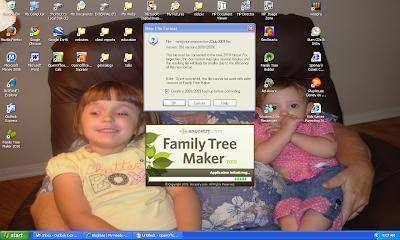
The message box says that the FTM 2008/2009 file format is not compatible with FTM 2010, and the file has to be converted to the new format, which should result in a smaller file size. I clicked on the box to create a backup of my FTM 2009 file also. All of that took a little more time to do. Finally, the program started and the "Plan" workspace screen looked like this:
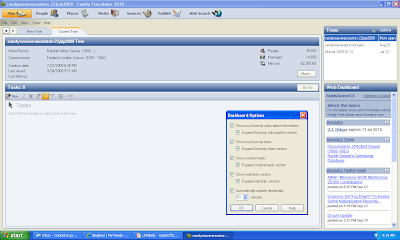
It looks like it loaded access to the three different trees I had in FTM 2009, as evidenced by the upper right hand corner display titled "Trees." Also on the right-hand panel is a new "Web Dashboard" box with a listing of my Ancestry.com Member Trees and the most recent Twitter feeds from Ancestry.com.
The Web Dashboard had an "Options" link so I clicked that to see what could be done on the Web Dashboard, and a panel with a bunch of check boxes appeared, as shown above.
I wanted to see what options there were to create a new tree, so I went to the "New Tree" tab in the main panel, and started to enter a new tree:
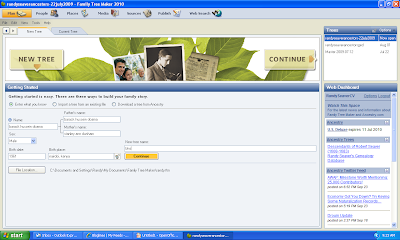
It would be too difficult to enter all of my family tree data, so I clicked on the box to "Import a tree from an existing file." FTM 2010 permits imports from any Family Tree Maker file from Version 5 on, a GEDCOM file, Personal Ancestral File, Legacy Family Tree (I wonder which versions?), and The Master Genealogist (which versions?). The Help function did not tell me which versions can be imported.
I wanted to import my most recent Family Tree Maker 16 working file, so I browsed my computer data files and found it and clicked on it to put it in the File name box and renamed it with a date:
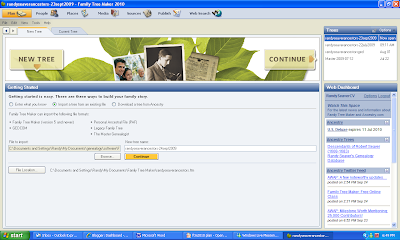
It took quite a while to load into FTM 2010, since it has over 38,000 persons and over 15,000 families, but only 18 media items attached. As it neared the end of the processing and creating the tree, the progress bar filled out:
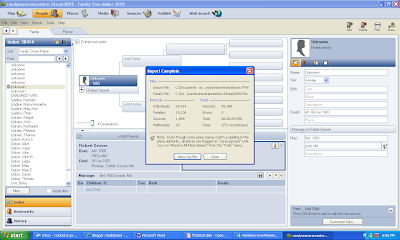
There is one other option to creating a new tree - I could download a tree from my Ancestry.com Member Trees. I clicked on the button on the "Plan" workspace to do that and saw:
I wanted to check the file sizes, but installing FTM 2010 resulted in the FTM 2009 files being converted to FTM 2010 files and I could not determine the FTM 2009 file sizes. The FTM 16 Family File size was 38.773 megabytes (which included the media items). The FTM 2010 Family File size is 62.920 megabytes, plus 6.580 megabytes for the media items. I tried to import the FTM 16 Family File into FTM 2009 and put it in a separate file folder, but an error occurred and it did not load. The same thing happened with a FTM 16 Backup File upload to FTM 2009. That's frustrating - I want to be able to compare FTM 2010 with FTM 2009 and need to use the same "starter" file.
My plan is to NOT do a comprehensive review of FTM 2010, since I did one for FTM 2008 last year. I will be looking at the things that have changed since FTM 2008 and 2009, however.
An Endorsement for Genea-Musings?

Best Online Databases for Cemeteries
Have you missed some of the earlier issues of the Graveyard Rabbit Online Journal? Click on the list of archived monthly journals in the right sidebar, or click on the individual column articles, listed by authors, on the right sidebar. The columnists (who write an article every two months) are:
* "The History Hare" by footnoteMaven
* "Tech T.I.P.S." by Denise Olson
* "The Educated Rabbit" by Sheri Fenley
* "Photo Monument" by Julie Cahill Tarr
* "Digging for Answers" by Randy Seaver
* "Graveyard Guru" by Stephanie Lincecum
* "Rabbit's Tale" by various contributors
Enjoy!
What's a Graveyard Rabbit, you ask? Check out The Graveyard Rabbit blog for the answer!
Wednesday, September 23, 2009
Blogger "Ancestry Insider" Interview
You can see the YouTube interview on Lisa's Genealogy Gems News blog here.
Enjoy! I did.
I actually met The Ancestry Insider back in January when I was in Salt Lake City, and no, he did not wear his mask while we drove down to Provo together. But we found out that we share common ancestry in Essex County, Massachusetts. And we're stuck on the same common ancestor! Small world.
Footnote Pages Revisited - some questions
At the time, I wondered if Footnote.com would find a way to enable combining the Footnote Page created from the 1930 Census data with a Footnote Page created from one of the other "seedings" from the Social Security Death Index or World War II Army Enlistment Records databases. Apparently, there is still no way to do this, and it's possible to have three separate Footnote Pages for the same person.
When I checked Footnote.com today, I noticed several puzzling things:
I clicked on the "Pages" link in the top (light brown) menu bar, and I got this screen:

The screen above proudly claims that there are over 80 million "Foonote Pages" [sic] from U.S. government records (from the Social Security Death Index and World War II Army Enlistment Records).
Huh? What happened to the 130 million "U.S. Government Records" that comprise the 1930 United States Census? Shouldn't the proud web page headline say "over 200 million" and include the 1930 Census records?
I put my father's name in the search box and found both Footnote Pages created for him. Here is the 1930 U.S. Census Footnote Page for Frederick W. Seaver:

On the above Footnote Page, I have added a Link to the other Footnote Page for my father, Frederick Seaver, which was created from the Social Security Death Index and includes photos, vital records and stories about my father - shown below:

So it seems that nothing much has changed here in six months.
I do really like Footnote Pages, and I hope that Footnote.com will continue to "seed" the collection with other U.S. Government databases (I suggest the 1790, 1820, 1850, 1880 and 1900 census records, the Revolutionary War, War of 1812 and Civil War Military Service records - that would take the collection back to the Revolutionary War time) to make it easy for Footnote users to add person details and other records to Footnote Pages.
However, I do think that Footnote.com needs to find a way to combine separate Footnote Pages for the same person.
Genoom blog has 45 "great"genealogy web sites
There are many useful sites on this list, with topics including records, documents and databases; DNA testing; last names; blogs and discussions; events; education and resources.
At least one of the sites listed is dormant - can you figure out which one it is?
What other genealogy website should be on this list in your opinion? Please let me know in comments!
Wordly Wednesday: Family Photographs - Post 72: David D. Smith on the Telephone
This photograph is from the collection of pictures given to me by my mother during the 1988 to 2002 time period:

Tuesday, September 22, 2009
One more small bit of information
It turns out that the vital records, probate, tax and land records (and presumably other court records) for Dodge County burned in 1877. Oh well! I wondered why there weren't any microfilmed records for this time frame in the Family History Library Catalog (although there is an undated land records index book that I need to see).
What other resources are there for Dodge County? I found the Dodge/Jefferson Counties Genealogical Society website that has collected quite a bit of information for the 19th century, including newspaper clippings, cemetery listings, etc.
I clicked on the Burnett township cemetery listings for Burnett Corners Cemetery (Section 20 NW), and checked for SMITH, and there is Devier's adopted mother, Mary (Bell) Smith, who died 12 May 1865, aged 60 years, 19 days at death, the wife of R. Smith (that's Ranslow) in row 9. The death date matches the family paper information that I have handed down over four generations, so I know it is her (there is another Mary Smith who died 25 December 1864, aged 58 years, 7 days).
I still haven't solved my "missing land and tax records" problem, but I've added one more small piece to my ongoing Smith puzzle. I'm going to write a query to the Dodge/Jefferson Counties Genealogical Society asking for advice. If anybody has information about 1857-1867 land and tax information for Dodge County, Wisconsin, please contact me at rjseaver@cox.net.
Proven Genealogy Research Strategies
This was the case on Thursday afternoon, when I had to choose between going to the Ancestry.com briefing for genealogy bloggers, John Colletta's "Stories that Instruct: Using Case Studies to Teach Genealogy Methodology," David Rencher's "Proven Research Strategies that Transcend Geopolitical boundaires," and Thomas Jones's "Models for Proving Parentage." I chose to attend the Ancestry.com briefing, and reported on it in Day 2 at the FGS Conference - Post 2. But I know that I missed these three excellent presentations that I wanted to attend.
Thank goodness for the syllabus material, which was available online before the conference, and provided on CDROM at the conference, to registered attendees. I printed off the syllabus material for these three presentations (and others) last week and took them with me on my trip to Santa Cruz - I read them at the airport and on the airplane.
By far, the most useful presentation that I missed was David Rencher's, which was the Helen Leary Lecture sponsored by the BCG Education Fund. David's handout was four pages of very helpful information, which summarized much of Helen F.M. Leary's book North Carolina Research: Genealogy and Local History, 2nd Edition, Raleigh, N.C., North Carolina Genealogical Society, 1996.
In this presentation, Rencher summarized research strategies for genealogists - and noted that "When followed, these principles will produce the desired outcomes a higher percentage of times than the Attention Deficit (ADD) approaches many of us believe we don't practice." OUCH - that hurt! He presented strategies for a sound beginning, family sources, vital records, census records, land records, tax records, wills and burned counties.
These recommended strategies are timeless, and do not depend on online databases or microforms - they do require researchers to find resources wherever they may be - in attics, vertical files, book shelves, courthouse boxes, etc.
David's conclusion says:
"Whether or not you have North Carolina ancestral research, you should consider owning a copy of North Carolina Research or locating a copy in your local library or possible purchasing a copy for the library. Studying the strategy sections with a focus on your area of interest will likely illuminate a number of ways you can improve the results of your research and achieve your desired research objectives."
Have you read this book? Does it sound helpful? It does to me! I'm convinced - I found that it is available through www.Amazon.com (although expensive). I also checked www.WorldCat.org and found that there is a copy at the Carlsbad City Library. It sure sounds to me that my Chula Vista Genealogical Society needs to buy this book for the collection at the Chula Vista Library!
Monday, September 21, 2009
My Saturday Night Genealogy Fun Redux
DianaR commented that "Hey Randy - 97 divided by 4 is 24.25....I think you need to spin the wheel again ;-)" Thank you, Diana! Very gentle! William R sent me an email to kindly tell me that I erred also - thank you William! Only two of my over 800 readers caught the error and told me about it...c'mon folks, I do this intentionally just to see if you are reading carefully (um, actually, not...).
There have been over 40 blog posts on this subject - Thomas MacEntee has the list at Geneabloggers in SNGF – Ahnentafel Roulette. Thomas recently posted The Value of Play about SNGF - thank you, Thomas. Genealogists just wanna have fun, at least occasionally!
Anyway, as DianaR pointed out, my Ahnentafel Roulette number was really 24, not 19. Where did I get 19? I guess I thought that my father would have been 77 years old, not 97. I didn't use a calculator or my fingers...and came up with 19! So, as you can see, I erred, and I need to make it right!
Here's #24, one of my second great-grandfathers:
David Jackson/D.J. Carringer was born 04 November 1828 in Greenville, Mercer County, PA; he died 20 January 1902 in San Diego, San Diego County, CA. He was the son of 48. Heinrich/Henry Carringer and 49. Sarah Feather. He married 25. Rebecca Spangler 16 October 1851 in Mercer County, PA. They had children Harvey Edgar Carringer (1852-1946), Henry Austin Carringer (1853-1946) and Effie Carringer (1858-1874).
Three facts:
* David Jackson Carringer was the migrant in my Carringer line (my maternal line), growing up in Mercer County PA, migrating to Louisa and Washington Counties, Iowa in the late 1850s, to Boulder County, Colorado in 1873, and to San Diego County, California before 1900, where he (and wife Rebecca) died. How I wish I had stories from these travels!
* David Jackson Carringer was listed as a carpenter in the 1860 US Census (Louisa County IA), as a farmer in the 1870 US Census (in Washington county IA), as a joiner and a carpenter in the 1880 census (Boulder County CO) and with no occupation in the 1900 census (in San Diego County CA), although he is listed as owning his home with no mortgage.
* It is evident that D.J. and Rebecca really respected education and were literate - the Carringer/Seaver family library had many books inscribed by one of these family members, including schoolbooks of each of the children. There are also many letters from D.J., Rebecca and Edgar to the Henry Austin Carringer family in San Diego that describe their life in Caribou, Colorado. An 1862 Bible contains several generations of births, marriages and deaths of the family. The books have been distributed to family members, and I have the letters and the family Bible pages.
There is my #24...
I am back from Santa Cruz (and had emails and blogs to read from Friday morning on...) and need to go read my snail mail and newspapers tonight, then tackle my long to-do list for the next eight weeks. I have two ProGen reports to complete, two columns to write, four Beginning Computer Genealogy lessons to teach, three genealogy programs to prepare and present, and one library lecture to prepare and present. More on most of these in due time! Now - I need a nap!
Sunday, September 20, 2009
"Be Fruitful and Multiply" lived out
Soem key paragraphs:
"Rachel Krishevsky passed away at the age of 99, leaving behind no less than 1,400 children, grandchildren, great-grandchildren, and even great-great-grandchildren. In accordance with haredi custom, Krishevsky brought up her children to see children as a great joy. Her children subsequently adopted her outlook and produced 150 children of their own.
"These 150 children continued the commitment to be fruitful and multiply and themselves had no less than 1,000 children. From here, the lineage continued even further, and Rachel Krishevsky was blessed with a few hundred great-great-grandchildren."
Isn't that story amazing? Can't you just imagine how much money she spent on birthday and anniversary cards and gifts? And if every one of the descendants sent her cards and gifts on her birthday, it would certainly boost the Israeli economy!
A family tree showing all of her descendants would probably cover a wall in the family room. This would be a good job for The Chart Chick (but it might have to be in Hebrew?).
For comparison purposes, my parents would have been 90 and 98 this year, and have 14 descendants!



